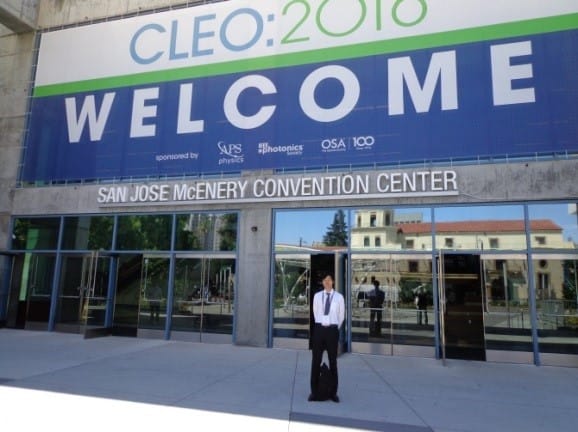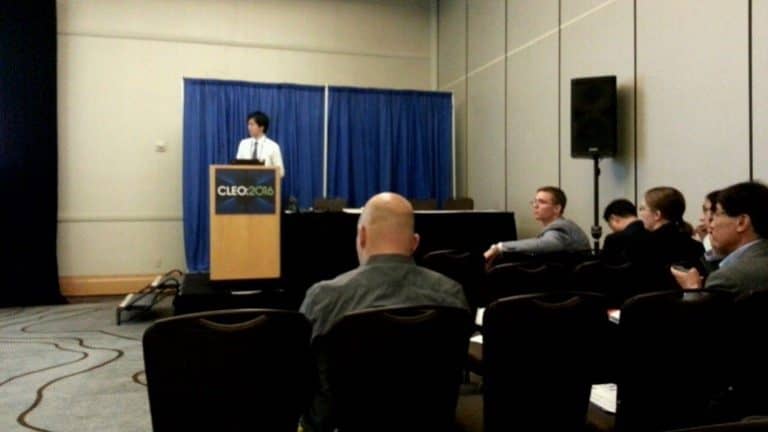CLEO 2016 Ryo Suzuki
Research
CLEO 2016 Return Report
Ryo Suzuki
Dates: June 5 - 10, 2016
Location: San Jose Convention Center, San Jose, California, US
The following is a report on the research results presented at CLEO:2016 (Conference on Lasers and Electro-Optics) held in San Jose, California, USA, and attended by the audience.
About the Conference
San Jose, California, where CLEO:2016 was held, is located about an hour and a half by train from San Francisco and is the center of Silicon Valley, where the headquarters of the world's leading IT companies such as Google, Oracle, and Adobe are located. CLEO is the largest international conference in the field of optics, where many high quality research papers are presented. The presenter stayed at Purdue University in the U.S. for about 5 months in FY2015, and it was refreshing to feel the network of researchers that was established during his stay.
2. Presentation by the reporter
Oral presentation of "Kerr comb generation with suppressed cavity-optomechanical oscillation in toroidal microcavity" was given at this conference. His presentation was in the new field of "optical frequency comb" for which he received the Nobel Prize in Physics, and all the sessions were well attended at the conference. The presenter's session included presentations from Purdue University, FEMTO-ST, NIST, Caltech, Columbia University, and other leading institutions in this field. The presentations were divided into 12-minute presentations and 3-minute Q&A sessions. The presentation was divided into a 12-minute presentation and a 3-minute Q&A session. As for the Q&A session, I was able to understand the English without any problem since it was a simple question and answer session on the influence of Cavity optomechanics in the measurement process. Since I had presented a poster at the previous CLEO, this was my first oral presentation at a CLEO, but I was able to complete my presentation without being too nervous.
3. Related announcements
The overall impression of the presentations related to optical frequency comb (optical car comb) using micro optical resonators, which is the research field of the presenter, is still that many research groups are using micro optical resonators made of silicon nitride material. In particular, EPFL, a top research institute, has presented many research presentations using this material, which may be due to its on-chip design freedom, stable experimental conditions, and material properties. Experiments have often been conducted with light in the telecommunication wavelength band, but in recent years, we felt that interest has shifted to the visible and mid-infrared regions. The following is a list of related presentations that may be of interest.
[SW1E.5] Generation of Dual Frequency Combs using Cascaded Microring Resonators
A. Dutt, J. Cardenas, Y. Okawachi, C. S. Joshi, X. Ji, K. Luke, A. L. Gaeta, and M. Lipson
[JTh4B.5] Silicon-Microresonator-Based Mid-Infrared Dual-Comb Source
M. Yu1 , Y. Okawachi1 , A. G. Griffith, M. Lipson, and A. L. Gaeta
One of the applications of optical Kerr combs is "dual comb spectroscopy", which is a spectroscopic method to identify substances by observing their absorption spectra using two optical frequency comb light sources with different repetition rates. In FT-IR, there is a mechanical drive to delay the two optical pulses, but in dual comb spectroscopy, the difference in the repetition frequency of the two pulses corresponds to the difference in the repetition rate of the two pulses. pulse repetition frequency difference. This dual comb spectroscopy has been realized with conventional optical frequency comb light sources, but has not been demonstrated even in a simplified manner with optical Kerr comb light sources. In this presentation, two silicon nitride micro optical resonators are arranged in series and parallel to generate two optical carcoms from a single pump laser source (one in the telecom wavelength band and the other in the mid-infrared band). Instead of using wavelength sweep of the pump laser, an integrated heater is used to tune the resonance wavelength for generation. In the telecommunication wavelength band, optical Kerr combs are generated at repetition rates of 444.9 GHz and 453.3 GHz, with a frequency difference of about 8 GHz. Although these parameters are too large in frequency for dual-comb spectroscopy, this study may be positioned as the first dual-comb spectroscopy demonstration of an optical Kercomb. While miniaturization and low cost are major advantages of dual-comb spectroscopy of optical Kerr combs, the large repetition rate is a problem, and future research will probably move in the direction of improving this problem. In addition, since the optical Kerr combs generated by this method have the same center frequency, it will be necessary to filter half of the bandwidth of the generated optical frequency comb when actually using it for spectroscopy.
[JTh4B.7] Ultra-High-Q Silica-on-Silicon Ridge-Ring-Resonator with an Integrated Silicon Nitride Waveguide
K. Y. Yang, D. Y. Oh, S. H. Lee, and K. J. Vahala
Silicon nitride micro optical resonators are often used in optical carcom research because they can be integrated with waveguides and fabricated on a chip. On the other hand, the Q-value is limited to the order of the sixth power by the fabrication process, and there is still no resonator that simultaneously achieves high Q-value and waveguide integration on-chip. In this presentation, a silica disk micro optical resonator with a Q-value on the order of the eighth power of 10 was integrated with a silicon nitride waveguide by adding an additional process. The Q-value of the order of 10 to the eighth power was maintained after the process.
[FM1A.8] Bichromatically-pumped coherent Kerr frequency combs with controllable repetition rates
J. Yang1, S.-W. Huang, B. H. McGuyer, M. Yu, M. P. McDonald, G.-Q. Lo, D.-L. Kwong, T. Zelevinsky, and C. W. Wong
Dual pumping has the following advantages in optical Kercomb generation: 1. low threshold for FWM generation, 2. control of FSR and other parameters. In this study, after generating combs at 4-FSR intervals using a silicon nitride resonator, the optical car comb is controlled by performing a second pump at the 2-FSR resonance frequency. In particular, by tuning the detuning of the second pump, the mode spacing of the optical Kerr comb was controlled by 40 MHz. The two pump lasers are phase-locked using Menlo's optical Guyver comb. The number of studies on dual-combs is not large, but they have been published from time to time. In their presentation, they mentioned that the future work is to generate broadband optical Kerr combs with dual pumps.


- Categories
- 国際会議報告


